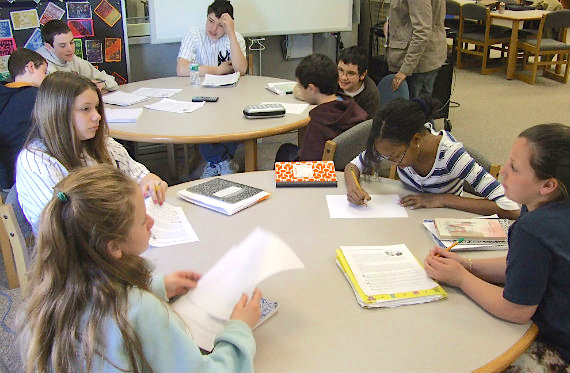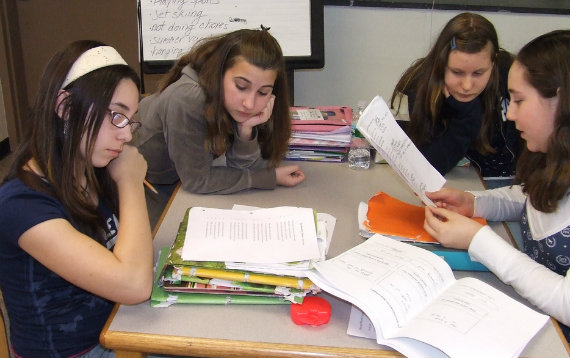Avoiding the Pitfalls of Student Group Work
 By Patrice Palmer
By Patrice Palmer
How do your students react when you tell them that they are going to work on a group project? Are their voices filled with glee or groans?
According to education columnist Maureen Downey in her newspaper article, “What Teens Resent: Classrooms Controlled by Students Rather Than Teachers,” most students hate group projects “and wonder why schools revere them.” Downey writes:
In the last few weeks, I’ve talked to several groups of students who outline the same scenario: Teachers don’t intervene when students commandeer classroom discussions or divert them. Repeatedly, students told me they could learn twice as much in half the time if teachers rein in their rambling peers.
So why have students work in groups if they dislike it so much? Because of the numerous benefits for our learners.
Avoid Group Work Pitfalls
It may seem like more work for teachers to spend time preparing students to work in groups, but it makes sense to set students up for success before they start sliding into some of the pitfalls of group work. It is not uncommon for one or two students to make all the effort, which defeats the purpose of group work. Conflicts may pull students apart instead of developing their relationships and promoting effective collaboration.
Some Benefits of Group Work
Students learn many valuable skills from groupwork which will help them not only at school, but in sports, volunteering and the world of work. The Conference Board of Canada’s Employability Skills 2000+ and the US Department of Education’s Employability Skills both list teamwork as an important skill for our students’ future.
Here are some benefits:
- develop communicate skills
- learn how to resolve conflicts
- increase student talking time
- share resources
- build on each other’s strengths and weaknesses
- develop time management and organizational skills
- apply problem-solving skills
How to Set Students Up for Group Work Success
I have found from my own experience as a teacher that one of the keys to successful group work is to take the time for students to understand themselves and their groupmates. Don’t assume that because students have worked on group projects before, they know what to do.
Here are three ways to set students up for successful group work (taken from my book Successful Group Work, which includes 13 teamwork activities):
- Getting to Know You
Give students sufficient time to get to know one another in class. Provide students with questions or brainstorm some questions with the class. Then have students pair up and allow 6 to 8 minutes for the interviews. Allow another 20-30 minutes (depending on the class size) to allow students to introduce their partner to the whole class based on the interviewing.
To make this activity a bit more interesting, I tell students that I am going to test their “listening” skills after the interviews. I write something specific about each student as they are being introduced. At the end of the interviews, I ask the class “Who in our class speaks three languages”? “Who in our class really loves basketball?”
This activity helps students to focus during the interviews and also helps them to recognize and respect each classmate’s diversity, differences and interests.
- Establish Ground Rules
This activity provides students with an opportunity to communicate how they prefer to work together and establish principles for dealing with each other. If trouble arises later, you can help students resolve issues by referring back to the ground rules.
Some examples might be:
- We all share the workload.
- We do not interrupt when someone is speaking.
- The Power of a Team
I believe that it is important for students to understand and experience the power of teamwork. I have used The Word Lists activity, below, many times over the years (and even as a trainer with adults). Here’s how this 20 minute activity works:
Procedure:
Elicit 15 words from the class for your word lists or prepare in advance. Write the words large enough on a flipchart or board so that the class can see them clearly.
Start off the lesson with a brainstorming session where students think of the benefits and the challenges of working in teams. If students have not had a chance to work in teams in an academic setting before, they may wish to think about other examples such as in sports, extra-curricular activities, or their families.
Then tell students they are going to participate in an activity that demonstrates how working in a team can be more efficient than working alone.
Procedure for the Individual List:
- Tell students that they are going to practice working on their own and also as part of a team. Let students know that they will have a chance to discuss this activity when it is completed.
- Tell students that you will show them a list of words for one minute. When the time is up, they will have one minute to write down as many words as they can remember.
- After one minute ask students for a count of the number of words they remembered. Start by asking students who remembered at least one word to stand up. Hopefully, the whole class will stand.
- Now ask students who remembered more than two words to remain standing while the others sit down.
- Then ask students who remembered more than three words to remain standing while the others sit down. Build up to higher numbers, so that at the end, the students who remembered the most words are still standing.
Procedure for the Team List:
- Tell students that they will repeat the same exercise with a new list of words. Now they will have only 30 seconds to look at the words. However, this time they can work as a team to recall as many words as possible.
- Give students two minutes to discuss a strategy they might use to get their best results as a team.
- Then follow the same procedures as for Part 1, but as a team they have only 30 seconds to make their list.
- Ask them to write their list on the second column on their paper.
Debriefing:
- Which list is more complete – the list you recalled as an individual or the list you recalled as a team? (Ideally, the list compiled as part of a team should be the longer list).
- What were the advantages and disadvantages of working on your own and as part of a team?
- What strategy did you use to get you best results?
Follow up the discussion by addressing the elements of what makes a team work well together. Some examples might be more effective working as part of a team, lighter workload, and shared brainpower, to name a few.
You’ll find other activities in my book that will help you to set your students up for success and more importantly, apply the skills learned in your class to other projects in school and eventually in the workplace.


































As a former English teacher, I used to like Literature Circles because each role was defined.